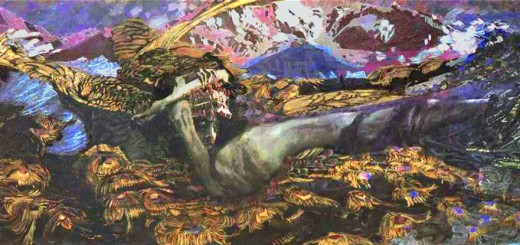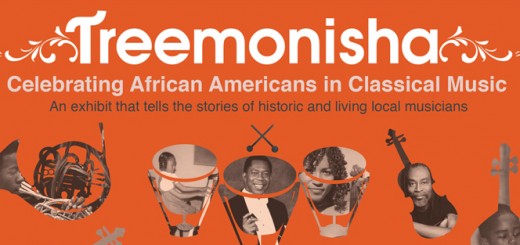Crossing Borders | Video Ex Machina: Video Games, Music Videos, and Participatory Culture
Each month, Echo partners with our friends at Ethnomusicology Review to bring you “Crossing Borders,” a series dedicated to featuring trans-disciplinary work involving music. ER Associate Editor Leen Rhee (leenrhee@ucla.edu) welcomes submissions and feedback from scholars working on music from all disciplines.
Video ex machina: Video Games, Music Videos, and Participatory Culture
Submitted by Michael Austin
In 1985, the British rock band Dire Straits released their album Brothers in Arms; the video for one of the most well-known songs on this album was “Money for Nothing” – a blue-collar anthem that decries the relatively easy life of a rock star who makes money simply by “bangin’ on the bongo like a chimpanzee,” getting his “money for nothin’” and his “chicks for free.” The video for this song, directed by Steve Barron, was among the first to use computer generated animation (or CGI), and featured two (literally) square working stiffs who installed microwave ovens and moved refrigerators and color TVs. It won “Video of the Year” at the 1986 MTV Video Music Awards for its innovation and creativity. Also in 1985 and 1986, Nintendo released its legendarily successful Entertainment System console in North America and Europe (respectively), proving that the Western world wanted its video games just as much as it wanted its MTV. The animation in “Money for Nothing” bore a striking resemblance to video game graphics; however, it would take several more years for video games to reach the same level of graphic fidelity and to support three-dimensional representation). Nonetheless, this video has inspired many more video directors to include CGI into their work over the past 30 years, provoking them to use this technology to create the surreal (and often absurd) aesthetics viewers have grown to expect.
Get More: Dire Straits, Money For Nothing, Music, More Music Videos
Obviously, participation is a large (and growing) part of video games. Not only do pre-packaged characters run on a pre-packaged stage created by the game designers, players can now choose the race or species, sex, or nationality of their avatar, dress them, and engage with other players in worlds that were also built by the players themselves. It seems as if participation and interactivity is becoming a larger part of music videos as well. Unsatisfied with simply playing the games, listening to the music, and/or watching the music videos created originally by the industry professionals, many music and video game fans immerse themselves within the “participatory culture” surrounding their favorite bands, performers, games and/or the characters within these games. In doing so, they create their own media artifacts as a means of creative self-expression and representation, resistance, or simply to express their love for a certain song or video game. This is often accomplished by re-appropriating clips from various media sources into a new music video and in doing so they construct new cultural meanings.
Some view the creation of these music videos as a “production-adjacent” activity – a type of fan labor that lies somewhere in the grey area between consumption of a mass-produced media product and the production of an entirely new media (art) object.[1] As new meanings are constructed using disparate media elements, the borders between each medium begin to blur.
Machinima, a portmanteau of “machine cinema,” is a filmmaking practice that utilizes the assets of videogame engines or other virtual worlds as source material. By controlling videogame avatars as digital puppets, using pre-existing videogame levels as scenery, compiling recorded clips of gameplay, and using voice-overs, non-linear editing, and other advanced techniques such as compositing and key-framing, “machinimists” (also called “machinimators”) are able to create films quickly, cheaply, and without many of the dangers or other physical limitations associated with filmmaking in real life. Machinima grew out of the practice of creating play-though demo videos of computer games such as DOOM (id Software, 1993) and Quake (id Software, 1996) in the mid-1990s. These games were popular environments in which to create machinima because they were some of the first games to allow players to edit their own maps, avatars, weapons, etc. (however, they were saved and shared as demo files that required the original game to view them). Machinima became considerably more popular in January of 2000 when Tritin Films released Quad God, a machinimatic film created in the game Quake III: Arena (Activision, 1999) and was distributed as a standard video file on websites such as machinima.com or though peer-to-peer file sharing services. Since the advent of YouTube and other similar online video-sharing services, the creation of machinima has grown in popularity as a participatory expression within fan cultures. For example, Red vs. Blue, a machinamatic comedy web series/military science-fiction parody created with the very popular game, Halo: Combat Evolved (Microsoft, 2001), reached an audience of over one million thanks, in part, to its free distribution online and is currently in its 13th season.
In recent years, many music videos have been based on video game themes and clichés, such as Leeni’s “Underworld, Boy Soprano” by Xiu Xiu, and Beck’s “Bad Cartridge,” but music videos are also being made with video games. Machinimatic music videos are a sub-genre of machinima wherein practitioners create new music videos for commercial recordings or re-create pre-existing live-action music videos within the virtual world of a videogame. Creators of machinimatic music videos no longer needed to write a film, nor hire or serve as voice actors, but instead only “direct” a music video using the characters of the video game. Machinimists can share their love for both a particular videogame and recording artist by creating these videos, bridging the gaps between two fan cultures on YouTube or other video sharing websites. It also capitalizes on the performative nature of video games. Henry Lowood writes:
Spectatorship and the desire to share skills were the cornerstones of the creation of a player community eager to create and distribute gameplay movies. The result was nothing less than a metamorphosis of the player in to a performer…[As a result,] game-based moviemaking has woven technology, virtual communities, play, and public performance together.[2]
As artifacts that straddle the interstitial space between several media, machinimatic music videos include intertextual references from the video game used to create them, an original music video they are meant to emulate, or even other music videos, internet memes, or other bits of popular culture. For example, Trace Osterham’s machinimatic music video for “Farrah Fawcett Hair” by indie pop duo Capital Cities was created in the virtual world of Second Life and features several references to the original music video and to another video in Capital Cities’ oeuvre, “Kangaroo Court.” In Osterham’s video, the TV screens and characters dancing in the background from the original video and the animal faces on the characters from “Kangaroo Court” appear on the small television screen in the machinimatic video.
Linden Lab, the creators of Second Life, are adamant in their assertion that this 3D online virtual environment is not a game. Spokesperson Catherine Smith asserts, “There is no manufactured conflict, no set objective. It’s an entirely open-ended experience.”[3] As such, Second Life easily lends itself to the creation of music videos because the video’s creator is less bound by a game’s formal elements, such as rules, game mechanics, objectives, the presence of enemies that might interrupt (or star in) a music video, etc.
Games in the life simulation video game series The Sims are similar to Second Life in that they are also a sandbox game (that is, a game wherein the player has the ability to alter the games’ environment substantially), but since they are actual games, a machinimist is more constrained by the rules of the game. For instance, there are seven life stages in The Sims 2. It can take up to 15 days for a character to grow from a baby to a teenager, but they can grow into a young adult early if the player decides to send the character to University. By completing certain in-game activities (such as completing chores or interacting socially with other characters), a player earns aspiration rewards, skill points, and other measures of success. The player must also attend to the needs of their avatar, such as the need to be fed, use the restroom, have fun, rest, etc. Keeping this in mind, consider a television program called “Video Mods” that aired on MTV2 from September 2004 to July of 2005 (created by Tony Shiff of Big Bear Entertainment) that presented professional machinimatic music videos produced by Shiff and his team. An exceptional example is a near scene-by-scene recreation of the official video of “Stacy’s Mom” by Fountains of Wayne created with The Sims 2.
Granted, Shiff and his crew were professionals with professional skills and software at their disposal. In order to create the characters needed for this video, they would have still have needed to raise them – that is, tend to the needs of “Stacy’s mom” for about 29 days until she becomes an adult. They would also need a character to get a job and earn enough money to be able to create a house with a swimming pool like the one in the original video, buy (or create) the requisite clothing, have the video’s characters interact socially, etc. Other machinimatic videos that are especially inter-textual, weaving together narratives from the original videos, the video games in which they are created, and the fan culture formed in the intersection between the two.
Although the materials that comprise these videos and games is an interesting starting point for investigating these media, we should heed Marshal McLuhan’s warning that “the content of a medium is like the juicy piece of meat carried by the burglar to distract the watchdog of the mind.”[4] Rather than simply focusing attention on the constituent elements themselves, I hope to concentrate future research in this area on an analysis of the juncture of materiality and textuality, i.e. what values lie between or are shared among video games and music videos, and what drives a fan culture to devote so much time and effort in order to participate. Again writing about the performative aspects of machinima, Henry Lowood argues that, “The importance of machinima for game studies is that it exemplifies the three-fold, interlocking nature of high-performance play: as performance of technical exploits, as performance of game skills, and as public performance for an audience.”[5] “High-performance play” is an important part of music videos, too – music videos showcase the technical exploits of a pop star though outrageous, over the top, or even sublime story lines, settings, costumes, dancing, etc., to showcase the singer’s skill as both a recorded performance and marketable, commercial secondary product associated with a recorded music single, album, or tour. I suspect that as both video games and music videos become more interactive, participatory, and Do-It-Yourself, the boundaries separating the two media will blur even further.
***
[1] See Sinnreich, Aram. 2010. Mashed Up: Music, Technology, and the Rise of Configurable Culture. Amherst: University of Massachusetts Press, 75.
[2] Lowood, Henry. 2005. “Real-time performance: Machinima and game studies.” iDMAa Journal, 2(1), 10-17.
[3] Kalning, Kristin. “If Second Life isn’t a game, what is it? March 12, 2007, accessed online: http://www.nbcnews.com/id/17538999/ns/technology_and_science-games/t/if-second-life-isnt-game-what-it/#.VWOtodNViko
[4] McLuhan, Marshal (1964). Understanding Media: The Extensions of Man. New York: McGraw-Hill, 18.
[5] Lowood, 15.



